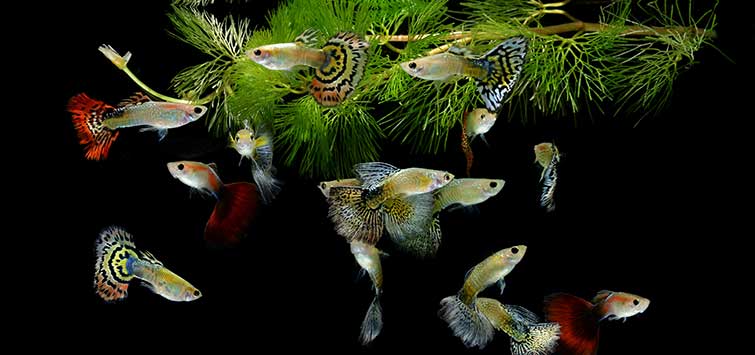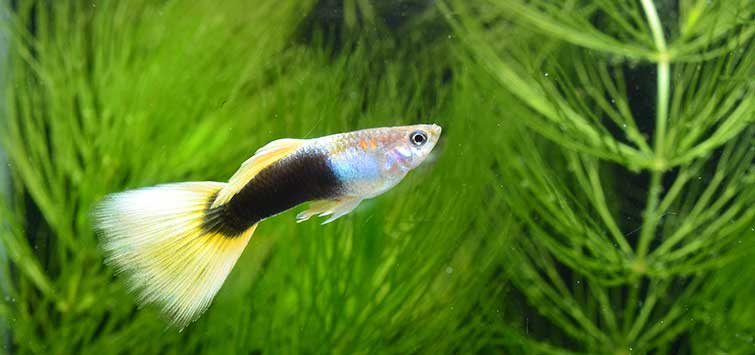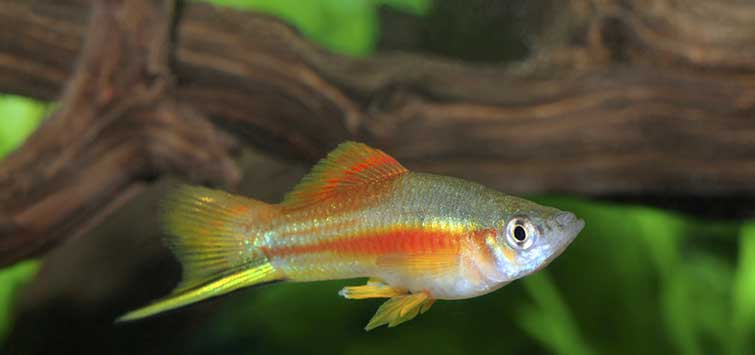Livebearers Unlimited: The Colony Tank: Bustin' the Breeder Trap Wide Open
Author: Ted Coletti
Baseball, hot dogs, apple pie…and breeder traps. They’re all traditions among American hobbyists. But as far as the lowly breeder trap is concerned, a new custom may be in order.
Breeding Traps
Livebearer breeding traps come in many forms, from simple square box frames covered with netting to elaborate (and some would say bizarre) contraptions that literally vacuum newborn fry into a secure nursery chamber. Some float on the surface, but most hang on the inside of your tank. Eventually, most of us evolve to fishbowls and mini tanks to collect our fry. While more spacious, these vessels are still smaller and unfamiliar to the expectant mother. And if a seasoned sponge or box filter is not handy, water quality will soon suffer.
What all these “fry catchers” have in common is that they are inadequate and stressful for most livebearers. The problem lies in their size. Going from a spacious aquarium to a small box stresses most fish, which lowers disease resistance. And the worst time to stress a livebearer is when birth is imminent. Breeding traps also do not provide an opportunity to witness the entire repertoire of birthing behavior and instincts, from the selection of a maternity site to the first actions of the fry.
The good news is that nearly all livebearers can be born and raised in the same tank with their parents with minimal loss if provided the right conditions. Exceptions include the Poeciliid tribe Gambusiini, with their predatory Brachyrhaphis, Gambusia, and Belonesox genera, and perhaps the voraciously dumb Ilyodon goodeids and some of the Asian halfbeaks (Hemirhamphidae) most notably. But even here, removal shortly after birth in their home tank is preferable to a breeding trap.
So this month, as we plan for 2007, I offer a New Year’s resolution: build a colony tank.
Enter the Colony Tank
The colony tank is a type of aquarium where the entire life cycle of a fish is experienced and on display; from reproduction to birth to maturity to death—all in the same aquarium. Flock breeding would be the technical term to describe such methods.
Breeding is only part of the joy of a colony tank. For it is this system that allows you, the hobbyist, to the travel alongside your fish and watch them develop throughout their years. A colony tank is very much an observation aquarium where you really get to know the intricacies of your fish. It brings you back to basics, and the wonders (and joy) of that first fish tank.
With a colony tank you will also better appreciate how a social hierarchy, or “pecking order,” develops. As your fry grow you will see the emergence of the alpha male, sometimes after a growing competition of sorts takes place, or after the previous alpha male dies. With Xiphophorus species, one usually encounters the “leap fish” phenomenon where the non-alpha males stealth themselves as females until large enough to challenge the hierarchy. Sparring between males for the choice females (and vice versa) will be on display. You will also learn why runts have not evolved out of the gene pool, as a small, sneaky mater does not have to go through the elaborate courtship rituals of his larger, more colorful brethren.
If you research your fish carefully before setting up your colony tank, you may be able to re-create their biotope, at least in terms of color and basic topography. Then you may better understand why a particular livebearer is shaped or colored the way they are. Watch a Belonesox ambush its prey from behind a plant, or understand why the gray-colored Gambusia affinis is less conspicuous swimming in open midwater, as is its mottled neighbor Heterandria formosa living amongst the muck of the matted bottom shoreline.
The Setup
Tank Size
Successful colony tanks require long aquariums. Although I have raised generations of several small species using standard 10-gallon tanks, this size does not create the social and generational zones that afford the best window into the world of a species. The workhorse of the fishroom, the reliable 30-inch 20 long is a better size for small to medium livebearers, as is its taller version, the 29-gallon. Once you start thinking swordtails and more active fish, going to 36-inch and longer tanks is warranted. The 48-inch tank is easily lighted with standard shop light fluorescent fixtures with a wide variety of bulbs. The most common 48-incher is the popular 55-gallon, which, like its 10-gallon cousin, is priced better than other sizes.
Decor
The decor for a livebearer colony tank should include a combination of floating and bottom plants. This is for both water quality and practical reasons. The exact mix will depend on your species. Newborn Poecilia fry usually head for the surface, while Xiphophorus and stream-dwelling livebearers stay near the bottom. Clusters of small stones around the tank are helpful here as well. Your choice of plastic or live plants will determine your lighting needs. But the plants mentioned below work well in low light (1 to 2 watts per gallon).
Plants
For floating plants, assuming most livebearers prefer hard water, you really can’t beat tropical hornwort Ceratophyllum submersum. This is a fish-club specialty plant common here in the New Jersey scene. Water sprite is another floater that works for some people, as does frogbit. Popped-off stems of plastic plants work in a pinch. Or you can go with one of my favorites, pothos, a common low-light house plant used extensively in offices. Keep the foliage above water and stick the stem in the tank. Roots will soon develop and form a surface maze.
Plant or rock clusters in the back corners and sides of the aquarium make for handy nurseries. Java fern or tropical hornwort are the most practical here, as they have no true roots and can be weighted down by small stones. Less gravel in your tank generally means a cleaner, healthier environment (and less maintenance!).
If you prefer more rooted species, you can’t go wrong with the easy and readily available low-growing Cryptocoryne wendtii or C. lutea, or ruby melon sword. Harder to find is the tall background plant Vallisneria spiralis. Although I could write a whole column on substrates, the above plants will do fine in a 1½-inch-thick seasoned substrate. Complete aquarium plant substrates that do the job well from day one are now available; a more flexible alternative is the use of small perforated pots sold in the pond departments of your aquarium-supplies dealer, clay garden pots, or plastic garden pots with holes punched in the sides. I will attest that netting out livebearers from a permanently planted aquarium is usually quite disruptive and vexing!
This leaves the center and front of the colony tank for courtship, mating, sparring, and other social behavior. Java fern or willow mosses (Fontinalis) make for good grazing/hiding places for fry in these open areas. A few sprigs placed throughout the tank and covered with a light coating of gravel created a nice carpet after a few weeks that could be easily trimmed. This generally improves fry retention.
Up and Running
It is not uncommon for your first drop of fry to be eaten. But with plenty of cover, grazing areas, and good feedings, some will survive. Sometimes it’s a good idea to raise the first drop of fry separately for them to gain some size before re-introduction to the colony.
The other fish in the tank will eventually grow accustomed to sharing their space with young’uns, and the colony will go into production without any protective measures on your part. This can be too much of a good thing as the competition, crowding, and concentration of secreted hormones inhibit the growth of young fish. There are different approaches to this dilemma. One can dispose of excess fish by bringing them to shops or local fish club auctions. Other hobbyists remove the adults after about a year of reproducing, which leaves only young fish that will quickly mature. This ensures you will always have a vibrant breeding colony.
Another tip for colony-tank maintenance is to avoid selective breeding if you want to maintain a species in peak health. This will limit the genetic diversity in your colony and could weaken the population over time.
I guarantee you will enjoy setting up a colony tank of your own. In this micro-community, you will observe the whole cycle of life, from birth to death, with all the interesting and complex social structures that occur in between. Can’t you picture Editor-in-Chief David Boruchowitz singing a Lion King song right now?
Dr. Ted Dengler Coletti has been an aquarist and freelance writer for over 20 years. He resides with his patient family, aquariums, and guitars in the New Jersey Skylands, and sits on the Board of the American Livebearer Association. He is a founder of the Northeast Livebearer Association and the Aquarium Hobby Historical Society. Questions, suggestions, and rare “Grady, you Dummy!” bumper stickers can be forwarded to tedcoletti@yahoo.com

.png?h=595&iar=0&w=2781&hash=5FD5E69473BCC22199FBFA2FB71B6033)



